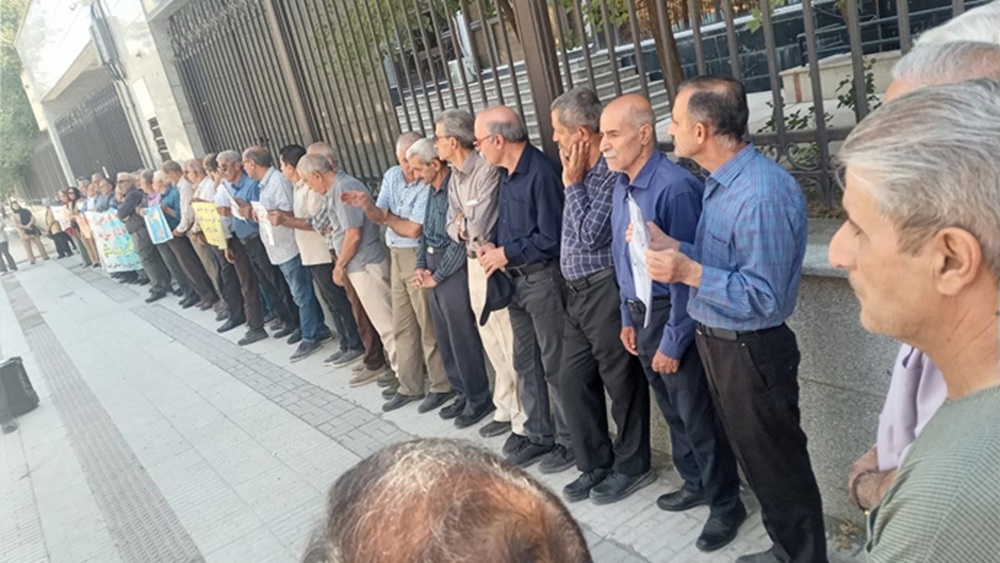Facebook
Twitter
LinkedIn
Pinterest
Reddit
Email
Print
 Kermanshah – Retirees’ protest gathering in front of the Social Security Organization – Sunday, September 7, 2025
Kermanshah – Retirees’ protest gathering in front of the Social Security Organization – Sunday, September 7, 2025
On Sunday, September 7, 2025, a powerful wave of defiant protests swept across Iran, revealing the deep and widening cracks in the clerical regime’s authority. From the capital, Tehran, to major cities like Ahvaz, Kermanshah, Rasht, and Shush, and industrial hubs like Gachsaran, citizens from all walks of life took to the streets. This synchronized wave of dissent, involving retirees, state employees, contract workers, students, and professionals, exposes the utter failure of the regime to provide basic necessities and highlights a population that is increasingly organized, fearless, and explicitly demanding an end to tyranny.
The Economic Collapse: “Our Tables Are Empty”
The primary catalyst for the protests was the regime’s catastrophic economic mismanagement, which has pushed millions into poverty. In cities across the country, retirees from the Social Security and Steel funds—the very people who built the nation’s infrastructure—rallied against pensions that fall far below the poverty line. In Tehran, retirees gathered in front of the Social Security Organization building, their chants directly linking their suffering to the regime’s priorities: “Stop the warmongering, our tables are empty!”
September 7—Kermanshah, western Iran
Retirees in Kermanshah gathered in front of the Social Security building to protest inadequate pensions and poor services.#IranProtestspic.twitter.com/pmnBjClt3t
— People’s Mojahedin Organization of Iran (PMOI/MEK) (@Mojahedineng) September 7, 2025
This sentiment echoed nationwide. In Shush, retirees chanted, “Enough oppression and tyranny, our tables are empty!” In Kermanshah, the protests took on a sharper edge, targeting the regime’s endemic corruption with slogans like, “The official’s son is on a treasure chest, the retiree is in agony!” The protests were not limited to retirees. In the southern oil city of Gachsaran, contract workers from the oil and gas company rallied to demand job security, demonstrating that discontent is festering even within Iran’s most vital economic sector.
A Broadening Front of Defiance
The protests on September 7 demonstrated that the resistance has expanded far beyond specific economic grievances to include professionals, students, and even families of prisoners. In Tehran, for the second consecutive day, applicants for the medical board and specialization certificate exams gathered outside the Ministry of Health, demanding transparency and accountability in a system they see as corrupt.
September 7—Tehran, Iran
Candidates for the board and specialized certification exams gathered for the second consecutive day in front of the main entrance of the Ministry of Health, raising their voices in protest.#IranProtests pic.twitter.com/EEEuMiG0Uw
— People’s Mojahedin Organization of Iran (PMOI/MEK) (@Mojahedineng) September 7, 2025
Meanwhile, university campuses have become new flashpoints. At Tehran’s Tarbiat Modares University, students protested the abysmal quality and disorganization of food services. At the Chamran Dormitory, students erupted in anger over a sudden price hike for the same low-quality meals.
One of the most striking events occurred in Kermanshah, at Dizelabad Prison, where a power cut paralyzed the family visitation hall. After being left in limbo, one courageous woman began protesting, inspiring nearly 200 other family members to join her. Their collective defiance forced the prison authorities to restore power within an hour.
From Demands for Bread to Cries for Freedom
While economic hardship serves as the catalyst, the slogans chanted in the streets reveal a profound political awakening aimed at the heart of the regime. The demands have evolved from calls for better wages to unequivocal calls for liberty. In Ahvaz, protesters chanted a powerful message of defiance: “We won’t live under tyranny, we will sacrifice our lives for freedom. Death to this slavery, shame on this slavery.”
September 7—Ahvaz, southwest Iran#IranProtests
Retirees of the Social Security Organization gathered in front of the organization’s provincial office to protest harsh living conditions and the trampling of their rights.
The protesters chanted slogans such as:
“We will not submit… pic.twitter.com/d68Q1MwqbX
— People’s Mojahedin Organization of Iran (PMOI/MEK) (@Mojahedineng) September 7, 2025
This political dimension was present across the country. Demonstrators demanded the release of political prisoners with the unified chant, “Imprisoned protesters must be freed.” In Kermanshah, retirees transformed their protest into a call for national mobilization, shouting, “Retiree, rise up! It’s not time to sit down!” This solidarity was further evident in their support for other oppressed groups, chanting, “We support the teachers of Kurdistan!” These slogans confirm that the Iranian people see their individual struggles as part of a single, unified fight against the ruling theocracy.
The protests of September 7 are a clear indictment of a bankrupt regime facing a populace that has shed its fear. The geographic scope of the demonstrations, the diversity of the participants, and the overtly political nature of the slogans prove this is a cohesive national movement for fundamental change.
